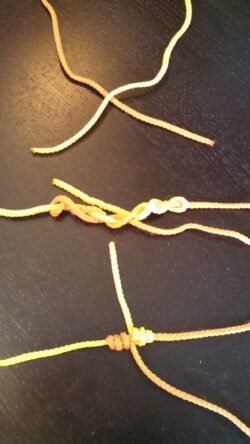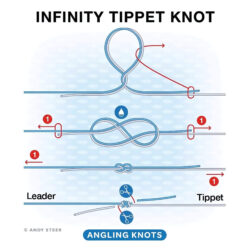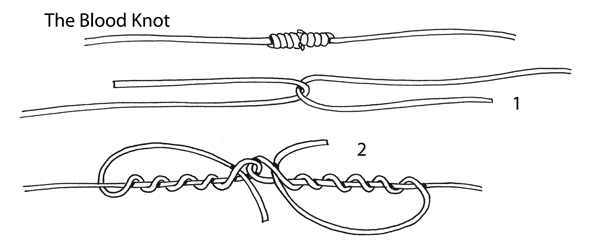 The Blood Knot is one of the hardest fly-fishing knots to tie. Every finger needs to be working together. This means that arthritis, wounds, and injuries may rule this knot out.
The Blood Knot is one of the hardest fly-fishing knots to tie. Every finger needs to be working together. This means that arthritis, wounds, and injuries may rule this knot out.
The Blood Knot is a great knot. It is the best tippet to tippet connection that I know of. Any and every knot will reduce the strength of any monofilament fishing line that you are using. As a Science teacher, I taught a lesson about measuring line strength after tying fishing knots. Students tied knots and added weights to find the breaking point. The Clinch Knot and Blood Knot always kept the best line strength.
I don’t know how the knot was named. Maybe it is because the knot results in fish getting caught and bloodied. It may also be because the angler may become bloody trying to tie it. Some anglers have good knot tying skills in their blood. Others simply struggle when tying any knot. This means lost fish and bloody frustrating moments.
 One story says that Blood Knots were made by sailors when making a punishment whip called a Cat of Nine Tails. The ends of the whip did more damage if the diameter of the cords were decreased and knotted. OUCH!
One story says that Blood Knots were made by sailors when making a punishment whip called a Cat of Nine Tails. The ends of the whip did more damage if the diameter of the cords were decreased and knotted. OUCH!
Learning to tie a proper knot takes practice. Start learning a knot using colored yarn that is plenty big enough to see and feel. Master the knots using this teaching yarn. Then go to big monofilament line before trying to tie with small tippet material. This knot can be tied using most materials.
Writing down and reading the directions to tie a Blood Knot may work for some but I suggest that you search How to tie a Blood Knot” on YouTube videos. Practice as you watch the animated demonstrations. Try using heavier fishing line or cord when first beginning. With practice, you can master finer tippets.
Practice your knots to make perfect. Your knot will only be as good as the quality of your tippet material or fishing line. The Blood Knot is perfect for building custom tippets. You can make a tippet from heavy monofilament to finer line for perfect casting and presentation. These homemade leaders are also cheaper.
Original fly casters used this knot to build fly lines from horse tail hairs. Multiple hairs made thicker, heavier lines that gradually got fewer and finer. Deer gut /sinews were also used. The finest deer guts made the tippet itself where the hook was attached.
You can use other knots to make line to line connections. Anglers that cannot master the Blood Knot often use a Surgeons Knot. The problem with this knot is that it makes a lump or knot in your line and is not as strong. The Blood Knot, like all knots will degrade line strength. On a Blood Knot the strength is decreased equally at the top and bottom of the knot. The Surgeons knot tends to always break on the bottom, where the finer tippet is attached. Many anglers debate which knot is best, but the “tie breaker” is that the Surgeon Knot believers cannot tie the Blood Knot.
Some anglers stick to clinch knots and use micro swivels at connecting points. A Tippet Knot is a simpler knot to tie but is not as strong when using finer tippets. The Double Uni Knot, J-Knot, and nail knot will also make the same connections, just not as strong.
Tie One On!
Montana Grant





